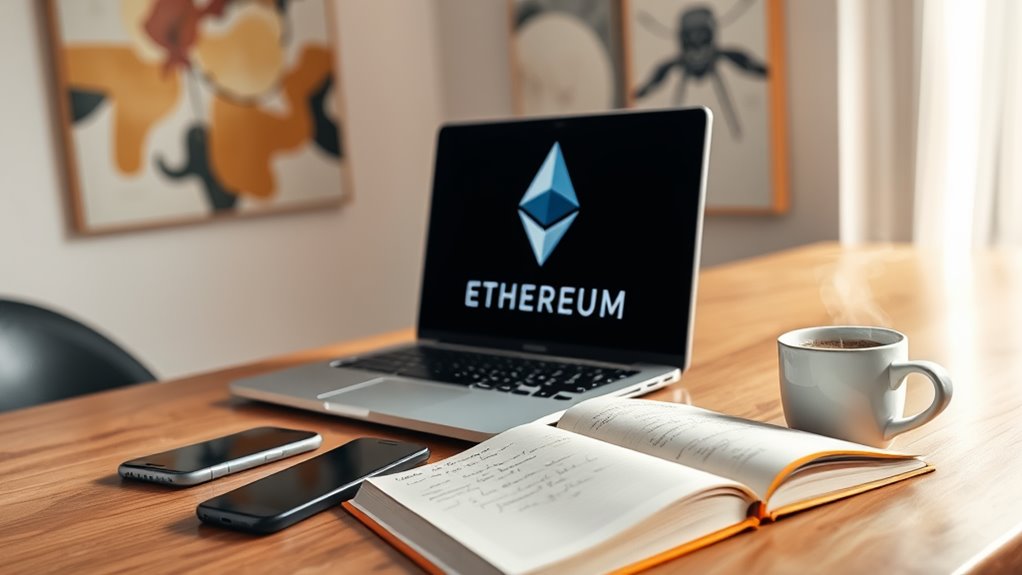
How to Buy Ethereum: A Step-by-Step Guide
Buying Ethereum involves selecting a reputable exchange like Coinbase or Binance, creating and verifying an account, and choosing a payment method such as bank transfer or credit card. After purchasing ETH, users should transfer their assets to a secure wallet—either software (MetaMask) or hardware (Ledger)—for protection against exchange vulnerabilities. Implementing strong passwords and two-factor authentication enhances security. The following steps explore the complete process in greater detail.
Key Takeaways
- Choose a reputable cryptocurrency exchange like Coinbase, Binance, or Gemini based on fees, security, and available payment methods.
- Create an account on your chosen exchange, complete identity verification (KYC), and set up two-factor authentication for security.
- Link your payment method such as bank transfer or credit card, with bank transfers typically offering lower fees.
- Purchase Ethereum by selecting ETH, entering your desired amount, and confirming the transaction details.
- Consider transferring your Ethereum to a secure wallet like MetaMask or a hardware wallet for long-term storage.
What Is Ethereum and Why Buy It

Although cryptocurrencies have proliferated in recent years, Ethereum stands out as a distinctive blockchain platform that offers far more than just digital currency. As the second-largest cryptocurrency by market capitalization, Ethereum enables the creation and execution of smart contracts and supports decentralized applications (dApps) across various industries.
Unlike Bitcoin, which primarily functions as digital money, Ethereum’s broader vision aims to transform industries through its programmable blockchain technology. The platform’s native cryptocurrency, Ether (ETH), serves as “fuel” for the network, powering transactions and network validation.
In 2022, Ethereum shifted to a proof-of-stake validation mechanism, markedly reducing its energy consumption. This transition enhances efficiency and sustainability, making Ethereum an attractive option for developers and investors alike.
Investors are attracted to Ethereum for its growth potential, versatility, and role in supporting innovations like NFTs and decentralized finance applications, though they should be aware of its inherent volatility.
Selecting the Right Ethereum Exchange for You

Once an investor understands Ethereum’s value proposition, the next step involves choosing the right exchange platform for purchasing ETH. Exchanges fall into three main categories: centralized exchanges (CEXs) offering high liquidity but requiring third-party trust, decentralized exchanges (DEXs) providing peer-to-peer transactions with enhanced privacy, and hybrid models combining features of both.
When evaluating exchanges, investors should consider several key factors: fee structures, security measures like two-factor authentication, available payment methods, user interface simplicity, and regulatory compliance. Additionally, platform liquidity and trading volumes markedly impact transaction speed and price stability. Exchanges with active communities often provide more competitive pricing and better market efficiency. Many platforms also offer educational resources and customer support to assist newcomers steering through the cryptocurrency ecosystem.
Finally, it is crucial to choose an exchange with strong security measures, such as enabling two-factor authentication, to protect your assets effectively.
Creating an Account and Verifying Your Identity

Opening an exchange account for Ethereum purchases typically begins with providing basic contact information like email and creating a secure password.
Most reputable cryptocurrency platforms require users to complete Know Your Customer (KYC) verification, which involves submitting government-issued identification documents and sometimes proof of address.
This verification process, though sometimes time-consuming, serves important security purposes and allows users to access the full functionality of the platform, including higher transaction limits and withdrawal capabilities. Additionally, selecting a beginner-friendly exchange can significantly enhance your experience by offering intuitive interfaces and helpful resources.
Account Setup Process
Setting up an Ethereum account involves several distinct steps that vary depending on whether users choose a decentralized wallet or a centralized exchange.
For decentralized options, users download a crypto wallet application that generates private keys and recovery phrases. This process requires no transaction fees or centralized registration.
When using centralized exchanges, users typically provide an email address and password, complete identity verification, and deposit fiat currency via bank transfer or card.
Security measures are essential regardless of the method chosen. Users should enable two-factor authentication when available and safely store recovery phrases offline.
Both software wallets (mobile apps or browser extensions like MetaMask) and hardware wallets (physical devices like Ledger) offer different security profiles. Additionally, understanding the key features of various wallets can help users select the best option for their needs.
The setup process is free, though purchasing cryptocurrency later will involve fees.
Identity Verification Requirements
Before purchasing Ethereum on most regulated platforms, users must complete identity verification procedures that comply with financial regulations. This typically involves a multi-step KYC (Know Your Customer) process where users submit government-issued photo identification, proof of address, and sometimes a selfie or video verification.
Most exchanges employ document verification through automated systems that check the authenticity of IDs against databases. Two-factor authentication adds an additional security layer, requiring verification codes sent via email or SMS.
These measures, while sometimes creating friction in the user experience, are essential for preventing fraud, money laundering, and maintaining regulatory compliance.
Users should expect verification to take anywhere from minutes to several days, depending on the platform’s processes and the accuracy of submitted information.
Understanding Ethereum Trading Fees and Costs

When investing in Ethereum, understanding the various fees and costs involved is essential for making informed decisions. Ethereum fees, paid in ETH, compensate network validators for processing transactions on the blockchain.
These fees consist of two components: a base fee that adjusts with network congestion and gets burned (removed from circulation), and a priority fee or “tip” that incentivizes validators to process your transaction faster.
Transaction complexity affects costs—simple ETH transfers require about 21,000 gas units, while smart contract interactions demand more.
To optimize costs, investors can use Layer 2 solutions like Arbitrum or Base, which process transactions off the main chain.
Additionally, timing transactions during periods of lower network activity and setting appropriate gas limits can greatly reduce expenses. Understanding how Ethereum gas fees are calculated, including the impact of network congestion and transaction complexity, is crucial for effective management of costs.
Setting Up a Secure Ethereum Wallet

A secure wallet represents the foundation of any Ethereum investment strategy. When establishing a wallet, users should choose from several options including software wallets for convenience, hardware wallets for maximum security, or paper wallets for offline storage.
The setup process typically involves downloading from official sources, generating unique key pairs, and securely storing recovery phrases. Popular choices include MetaMask for browser-based access, Trust Wallet for mobile users, and Ledger or Trezor for hardware security.
To maintain wallet security, users should implement strong passwords, enable two-factor authentication when available, and remain vigilant against phishing attempts. Regular software updates are essential to patch security vulnerabilities. Additionally, understanding the types of Ethereum wallets can help users make informed choices based on their needs.
Most importantly, recovery phrases should be stored offline in secure locations, as they represent the only way to regain access if credentials are lost.
Methods to Fund Your Account and Buy Ethereum

Funding your Ethereum purchase requires selecting a suitable payment method from options like credit cards, bank transfers, or cryptocurrency exchanges.
Each payment method offers different processing times, fees, and accessibility, making it important to choose one that aligns with your needs and timeline.
Security measures such as two-factor authentication, encrypted transactions, and verified payment gateways help protect your financial information during the funding and purchasing process. Additionally, it’s essential to understand the potential fees associated with credit card transactions to make informed decisions.
Payment Methods Overview
Several payment methods exist for purchasing Ethereum, each with distinct advantages and considerations.
Bank transfers offer lower fees but may take longer to process, while debit and credit cards provide immediate purchases at higher fee rates—Gemini, for example, charges 3.49% on debit transactions.
PayPal integration is available on select platforms like Coinbase, though availability varies by location.
Wire transfers are often free on exchanges such as Gemini but require more processing time.
For peer-to-peer transactions, users can transfer directly between wallet addresses or scan QR codes.
When executing orders, investors can choose between market orders for immediate purchase at current prices or limit orders that execute only when a specified price is reached.
Many platforms also support fractional purchases, allowing users to buy portions of Ethereum.
Transaction Security Measures
Securing transactions when buying Ethereum requires implementing multiple protective measures throughout the purchase process. Investors should verify recipient addresses, enable two-factor authentication, and implement strong access controls to prevent unauthorized transfers.
| Security Measure | Purpose | Implementation |
|---|---|---|
| Two-Factor Authentication | Prevent unauthorized access | Use authenticator apps or hardware keys |
| Private Key Protection | Secure ownership credentials | Store in hardware wallets or encrypted storage |
| Transaction Monitoring | Detect suspicious activity | Enable notifications for all transactions |
| Withdrawal Whitelisting | Limit transfer destinations | Pre-approve trusted addresses only |
Creating strong passwords, using secure networks, and keeping software updated further enhances transaction security. Additionally, using secure wallets can significantly reduce the risk of losing your digital assets to hacks or theft. Exchanges offering features like IP restrictions and thorough KYC procedures provide additional layers of protection. Regularly backing up wallet information ensures recovery options remain available if primary access methods fail.
Storing Your Ethereum Safely After Purchase

Once investors have successfully purchased Ethereum, they face the critical task of storing their digital assets securely. The choice between hot and cold wallets depends on individual needs and risk tolerance.
Hot wallets, including software, mobile, and exchange wallets, offer convenience for frequent transactions but present higher security risks. Cold storage options like hardware wallets and paper wallets keep assets offline, providing superior protection against hacking attempts.
Choose your Ethereum wallet wisely—convenience comes with risks, while offline storage offers superior protection.
For ideal security, investors should consider implementing additional measures such as two-factor authentication, strong passwords, and regular software updates. Crypto wallets store private and public keys, which are essential for accessing and managing digital assets.
Non-custodial wallets give users full control over their private keys, while multi-signature functionality adds an extra layer of protection for significant holdings.
Regardless of the chosen method, safely storing recovery phrases is essential to prevent permanent loss of assets.
Market Timing Strategies for Ethereum Investments

Although Ethereum markets operate 24/7, investors who implement strategic timing approaches can greatly improve their chances of success. Market timing strategies typically fall into several categories based on the investor’s goals and time horizon.
Many traders capitalize on regional session activity, with Asian, European, and American trading hours each offering different liquidity profiles and opportunities. Day traders focus on capturing short-term price movements within 24-hour periods, while swing traders hold positions for days or weeks to benefit from medium-term trends.
For long-term investors, dollar-cost averaging provides a methodical approach by investing fixed amounts at regular intervals, regardless of price fluctuations. This strategy helps mitigate the effects of Ethereum’s notorious volatility while still allowing participation in the asset’s potential growth over time. Additionally, as Ethereum continues to evolve with technological advancements, such as the transition to Ethereum 2.0, timing strategies may need to adapt to emerging market conditions and opportunities.
Frequently Asked Questions
Can I Mine Ethereum Instead of Buying It?
Traditional Ethereum mining is no longer possible after the 2022 changeover to proof-of-stake. Individuals interested in mining cryptocurrency could consider Ethereum Classic instead, which still uses proof-of-work, or explore staking ETH.
How Do I Convert Ethereum to Other Cryptocurrencies?
Like swapping dance partners, converting Ethereum involves using cryptocurrency exchanges. Users select trading pairs, submit orders, and pay transaction fees. Different platforms offer various options, with exchanges like Binance, Coinbase, and Kraken being popular choices.
What Happens to Ethereum During Network Upgrades?
During network upgrades, Ethereum typically maintains functionality while implementing improvements. The network may experience brief disruptions as nodes update, but transactions continue processing. Upgrades enhance performance, security, and introduce new features without compromising existing assets.
Can I Cancel an Ethereum Transaction After Submission?
While pending, yes; once confirmed, no. Users can attempt to replace unconfirmed transactions with higher-fee replacements using the same nonce. MetaMask and similar wallets offer cancellation functions, though success isn’t guaranteed during network congestion.
How Do Ethereum Gas Fees Work During Peak Network Times?
During peak network times, Ethereum gas fees increase due to high demand. Users pay higher priority fees to compete for block space, while base fees automatically rise according to network congestion algorithms.
Conclusion
Buying Ethereum requires careful planning and attention to security. Like traversing a complex mountain trail, each step in the process—from selecting an exchange to securing your wallet—leads toward successful investment. By following this guide, investors can confidently enter the cryptocurrency market with a foundational understanding of Ethereum purchasing procedures, proper storage practices, and strategic timing considerations. Remember that cryptocurrency investments carry inherent risks despite their potential rewards.












